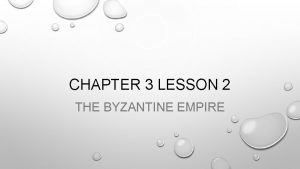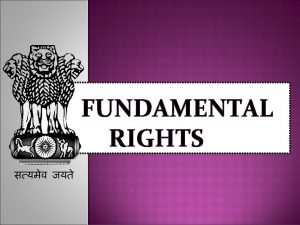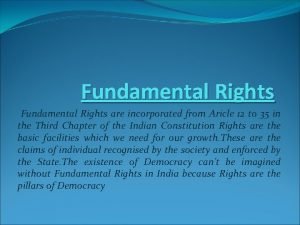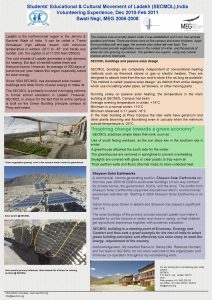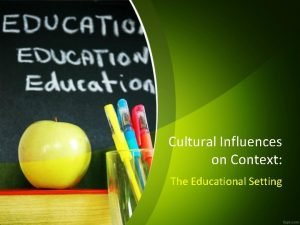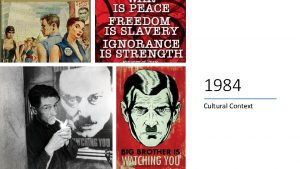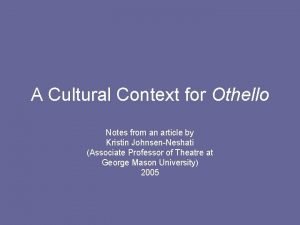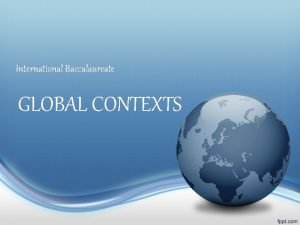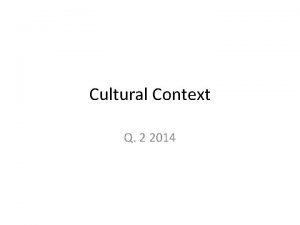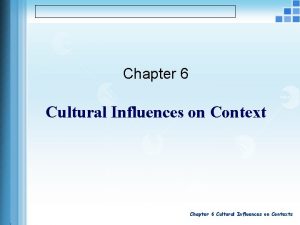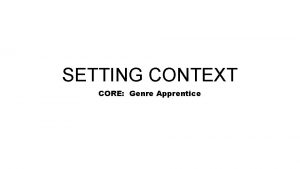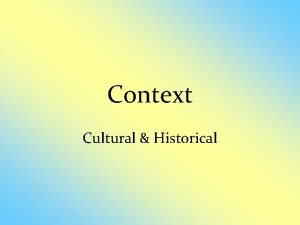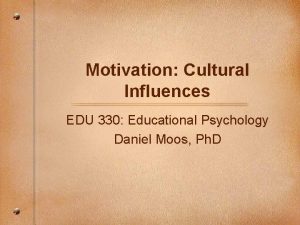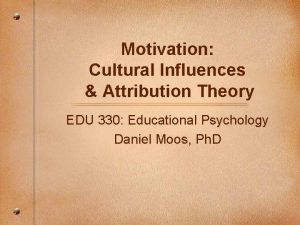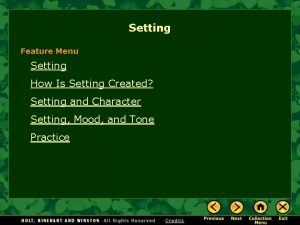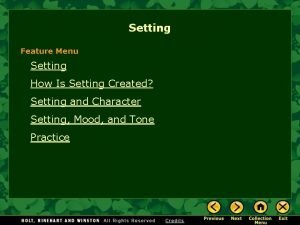Cultural Influences on Context The Educational Setting The

















- Slides: 17

Cultural Influences on Context: The Educational Setting

The Link Between Culture and Education • Gaining insight into cultures by studying its approach to education • School goals as they relate to the functions of the dominant society • Education and the informal knowledge of a culture • Cultural Diversity in Education A culture’s system of formal and informal education seeks to meet the perceived needs of its society.

The Condition of Education, 2008 • Public School enrollment is rising • Diversity of the student body is increasing How are these changes influencing our youth? In what ways can the diversity that exists in our educational institutions shape our culture?

What and How Cultures Teach • Schools are the primary source for perpetuation of culture in society • The formal education process is tied to the values and characteristics of that culture If these statements are true, who is defining culture in society and why? Knowing how teaching occurs in a culture: • Provides knowledge about the nature of the culture • Helps you understand relationships among students and between students and teachers • Helps you understand the importance that culture places on education

Learning the Character of a culture through taught subject matter Examples • China: collectivist, competitive • Japan: uniformity, group oriented, memorization-based • Post-Soviet Russia: rigorous, market-based • Spain: formative skills, national spirit, complementary skills How would we define American schools in the example above?

Multicultural Education The goal is to prepare students to become functioning, productive members of society. Challenges • Rapidly changing society • Inequality in social benefits due to race, gender, etc. • Potential clash between home and school cultures Aims • Teach cultural practices of others without misrepresentation • Teaching one’s own cultural practices without showing other’s views in a negative light

Cultural and Learning Cultural Learning Preferences The way in which individuals like to receive and process information • • Field Independence vs. Field Sensitivity Cooperation vs. Competition Trial and Error vs. “Watch, Then Do” Tolerance vs. Intolerance for Ambiguity Mastery Understanding Self Expressive Interpersonal

Culturally Responsive Teaching is. . . • Validating – Using the cultural knowledge, prior experiences, and performance styles of diverse students to make learning more appropriate and effective for them (Gay, 2000) • Comprehensive – Teachers realize not only the importance of academic achievement, but also the maintaining of cultural identity and heritage (Gay, 2000) • Multidimensional – Multidimensional culturally responsive teaching involves many things: curriculum content, learning context, classroom climate, student-teacher relationships, instructional techniques, and performance assessments (Gay, 2000) Gay, G. (2000). Culturally Responsive Teaching: Theory, Research, & Practice. New York: Teachers College Press.

Culturally Responsive Teaching is… Cont. . . • Empowering – Empowerment can be described as academic competence, self-efficacy, and initiative (Gay, 2000) • Transformative – Respecting the cultures and experiences of various groups and using these as resources for teaching and learning (Gay, 2000) • Emancipatory – Guides students in understanding that no single version of "truth" is total and permanent (Gay, 2000) Gay, G. (2000). Culturally Responsive Teaching: Theory, Research, & Practice. New York: Teachers College Press.

Cultural and Learning Relational Styles for Learning The manner in which people relate to one another • Dependency/Independence • Participation/Passivity • Impulsivity/Reflectivity

Cultural and Learning Cultural Motivation Styles Reasons to engage learning • • Intrinsic – internal drive to succeed Extrinsic – stimulated by external reward Learning on Demand – set curriculum Learning when Interested – only learn what is useful and interesting

Language Diversity in Multicultural Education Challenges • • • Language diversity in the classroom adds pressure to the educational process In 2006, 20% of all 5 to 17 -year-olds did not speak English at home (p. 345) English is a second language for nearly 10% of the US population (p. 345) “This lack of communal language in American classrooms is problematic, because language diversity confounds the educational process” (p. 345)

Language and Identity How do we teach assimilation without “stepping on the toes” of a student’s identity? Can we move students into a new educational culture without them feeling they are turning their back on their own culture?

Difficulties for English Language Learners • Having to learn the nuance of the language in addition to the subject matter • Academic Insufficiency • The stage at which students enter US schools differs • Assimilating to an educational system with different philosophies and objectives With the challenges of multicultural education being so great, are teachers equipped to handle the problems?

Competency Among Teachers With the challenges of multicultural education being so great, are teachers equipped to handle the problems? The text lists ways that teachers can become multiculturally competent, but are we asking too much of educators? What responsibilities lie with the educational institute versus the individual being taught? How helpful would DMIS evaluation be to teachers in multicultural environments?

Redefining the Classroom • • • Make Classrooms more welcoming to all cultures Focus on the areas that students have in common Set realistic goals based on individual students Adopt the philosophy of a differentiated classroom Use appropriate communication strategies – Immediacy & Empathy

Common Ground in Multicultural Classrooms From Matthew Lynch, Ed. D. Author of The Call to Teach and editor of The Edvocate • Careful Observations: multicultural education cannot be taught in a textbook. It must be developed by each educator based on a particular student group • Learning Style Guidance: help students discover their academic strengths by helping them discover their own learning style • Pride in Heritage: look for ways to emphasize the differences between students in a positive light Lynch, Matthew (January 9, 2014). The Call To Teach: Multicultural Education. The Huffington Post, Retrieved from http: //www. huffingtonpost. com/matthew-lynch-edd/the-call-to-teach-multicu_b_4568066. html
 Psychological influences on food choices
Psychological influences on food choices Example of cultural influences
Example of cultural influences What cultural influences shaped the byzantines?
What cultural influences shaped the byzantines? Table setting etiquette worksheet
Table setting etiquette worksheet Setting the table influences
Setting the table influences Right to constitutional remedies article 32 to 35
Right to constitutional remedies article 32 to 35 Images of cultural and educational rights
Images of cultural and educational rights Students' educational and cultural movement of ladakh
Students' educational and cultural movement of ladakh Spatial deixis
Spatial deixis Soal essay komunikasi nonverbal
Soal essay komunikasi nonverbal Nonagist
Nonagist Communicating across generational differences
Communicating across generational differences The cultural context of ihrm
The cultural context of ihrm Cultural context of education
Cultural context of education 1984 cultural context
1984 cultural context Cultural context of othello
Cultural context of othello Global context orientation in space and time
Global context orientation in space and time Cultural context never let me go
Cultural context never let me go


